非谓语having done的用法
- 格式:doc
- 大小:15.98 KB
- 文档页数:1

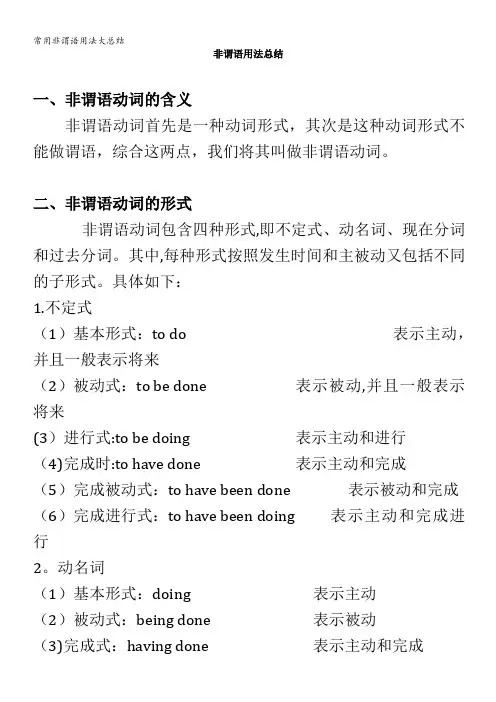
非谓语用法总结一、非谓语动词的含义非谓语动词首先是一种动词形式,其次是这种动词形式不能做谓语,综合这两点,我们将其叫做非谓语动词。
二、非谓语动词的形式非谓语动词包含四种形式,即不定式、动名词、现在分词和过去分词。
其中,每种形式按照发生时间和主被动又包括不同的子形式。
具体如下:1.不定式(1)基本形式:to do 表示主动,并且一般表示将来(2)被动式:to be done 表示被动,并且一般表示将来(3)进行式:to be doing 表示主动和进行(4)完成时:to have done 表示主动和完成(5)完成被动式:to have been done 表示被动和完成(6)完成进行式:to have been doing 表示主动和完成进行2。
动名词(1)基本形式:doing 表示主动(2)被动式:being done 表示被动(3)完成式:having done 表示主动和完成(4)完成被动式:having been done 表示被动和完成3.现在分词(1)基本形式:doing 表示主动和进行(2)被动式:being done 表示被动和进行(3)完成式:having done 表示主动和完成(4)完成被动式:having been done 表示被动和完成4.过去分词(1)done,及物动词的过去分词表示被动或完成;(2)不及物动词的过去分词表示主动或完成三、专题要点非谓语动词和独立主格结构主要用法如下:1。
动名词和动词不定式作主语、宾语;2。
只跟动名词作宾语的动词或动词短语;3.只跟动词不定式作宾语的常见动词;4.既可以跟动名词又可以跟动词不定式作宾语,且意义不同的动词或短语;5。
不定式、现在分词、过去分词作宾语补足语的区别;6。
不定式、现在分词、过去分词作定语时的区别;7。
不定式、现在分词、过去分词作状语时的区别;8。
动名词的复合结构在句中作状语;9.there be 结构的两种非谓语形式;10.独立主格结构在句中作状语;11。
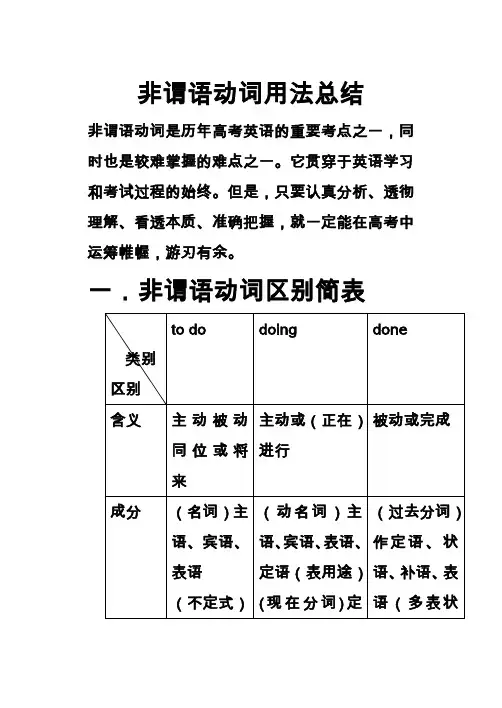
非谓语动词用法总结非谓语动词是历年高考英语的重要考点之一,同时也是较难掌握的难点之一。
它贯穿于英语学习和考试过程的始终。
但是,只要认真分析、透彻理解、看透本质、准确把握,就一定能在高考中运筹帷幄,游刃有余。
一.非谓语动词区别简表二.不定式的用法不定式不可作谓语,但它可以有自己的宾语、状语,构成不定式短语,在句中可以作主语、宾语、表语、定语(表用途)、状语或补足语。
高考对不定式的考查主要有不定式的时态、语态、作用、否定、省略、连词+不定式等。
作主语不定式作主语表示具体的动作,通常指一件已知的事或目的。
不定式作主语时,谓语动词用单数。
eg:To say is a thing,to do is another.(说是一回事,做是另外一回事。
)(2)不定式短语较长时,通常放在谓语之后,用it作形式主语。
eg:①It is important to learn English well.(学好英语是重要的。
)②It is necessary for us to do the job well.(我们做好这项工作是必要的。
)③It is a great honor to be invited to give a speech here.(被邀请在这儿发表演讲是一个极大的荣幸。
)2.作宾语(1)常只用不定式作宾语的动词有:want,wish,hope,long,expect,desire,intend,decid e,ask,promise,aim,offer,agree,plan,learn,choos e,refuse,fail,manage,pretend等。
eg:①He refused to help me.(他拒绝帮助我.)②She has agreed to come tomorrow.(他已同意明天来.)(2) 不定式较长时,作宾语,也可用it代替,放在后面。
eg;I find it difficult to do the job well.(3) “特殊疑问词﹢不定式to do结构”具有名词特征,可作宾语。

高中英语:非谓语动词考点全总结!含义+用法+例题讲解,三合一教会你!非谓语动词的含义非谓语动词首先是一种动词形式,其次是这种动词形式不能做谓语,综合这两点,我们将其叫做非谓语动词。
非谓语动词的形式非谓语动词包含四种形式,即不定式、动名词、现在分词和过去分词。
其中,每种形式按照发生时间和主被动又包括不同的子形式。
具体如下:1. 不定式①基本形式:to do(表示主动,并且一般表示将来)②被动式:to be done(表示被动,并且一般表示将来)③进行式:to be doing (表示主动和进行)④完成时:to have done(表示主动和完成)⑤完成被动式:to have been done(表示被动和完成)⑥完成进行式:to have been doing (表示主动和完成进行)The teacher told us to do morning exercises. 老师让我们做早操。
The car to be bought is for his sister.要买的这辆车是给他的姐姐的。
She pretended to be reading when the teacher came into the classroom.老师进来时,她假装正在读书。
The thief is said to have escaped.据说小偷已经逃跑了。
The thief is said to have been arrested.据说小偷已经被抓住了。
She is said to have been working in the factory over the last 20 years.据说在过去的20年里,她一直在这家工厂工作。
2. 动名词①基本形式:doing (表示主动)②被动式:being done(表示被动)③完成式:having done(表示主动和完成)④完成被动式:having been done(表示被动和完成)Travelling in space by ordinary people will be common in the future.在未来,普通人在太空旅行将会是普遍的事情。
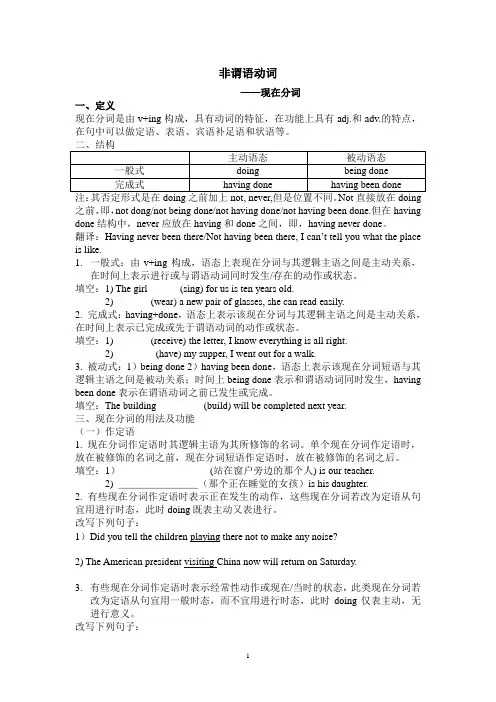
非谓语动词——现在分词一、定义现在分词是由v+ing构成,具有动词的特征,在功能上具有adj.和adv.的特点,在句中可以做定语、表语、宾语补足语和状语等。
之前,即,not dong/not being done/not having done/not having been done.但在having done结构中,never应放在having和done之间,即,having never done。
翻译:Having never been there/Not having been there, I can’t tell you what the place is like.1.一般式:由v+ing构成,语态上表现在分词与其逻辑主语之间是主动关系,在时间上表示进行或与谓语动词同时发生/存在的动作或状态。
填空:1) The girl ______(sing) for us is ten years old.2) _______(wear) a new pair of glasses, she can read easily.2. 完成式:having+done,语态上表示该现在分词与其逻辑主语之间是主动关系,在时间上表示已完成或先于谓语动词的动作或状态。
填空:1) _______(receive) the letter, I know everything is all right.2) ________(have) my supper, I went out for a walk.3. 被动式:1)being done 2)having been done,语态上表示该现在分词短语与其逻辑主语之间是被动关系;时间上being done表示和谓语动词同时发生,having been done表示在谓语动词之前已发生或完成。
填空:The building _________(build) will be completed next year.三、现在分词的用法及功能(一)作定语1. 现在分词作定语时其逻辑主语为其所修饰的名词。

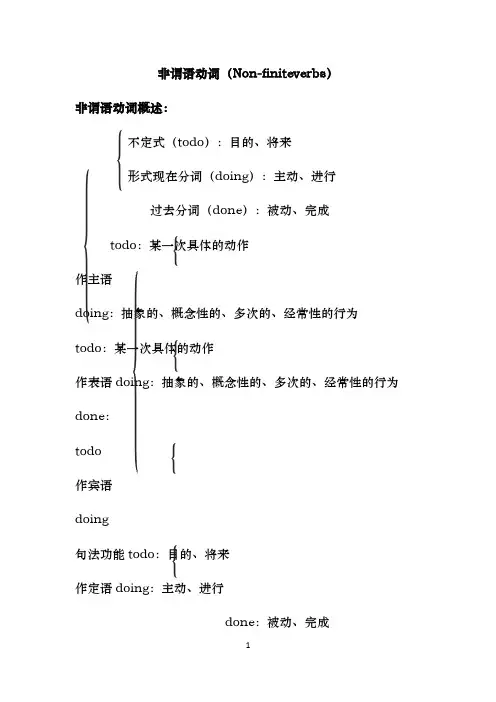
非谓语动词(Non-finiteverbs)非谓语动词概述:不定式(todo):目的、将来形式现在分词(doing):主动、进行过去分词(done):被动、完成todo:某一次具体的动作作主语doing:抽象的、概念性的、多次的、经常性的行为todo:某一次具体的动作作表语doing:抽象的、概念性的、多次的、经常性的行为done:todo作宾语doing句法功能todo:目的、将来作定语doing:主动、进行done:被动、完成todo:目的、将来作宾补doing:主动、进行done:被动、完成todo:目的、将来作状语doing:主动、进行done:被动、完成独立成分作状语n./pron.+todo/doing/done独立主格结构with的复合结构GrammarI:非谓语动词的形式(一)过去分词:过去分词只有一种形式,就是一般式done。
①单独表示一个被动的动作;②也可以单独表示动作已经完成;③还可以同时表示被动和完成。
(二)现在分词的各种形式:(三)主动被动用法一般doing beingdone doing的动作与谓语动作几e.g.1._______________(hear)thenews,theycouldn’thelpla ughing.e.g.2.Not________________(finish)thetask,theyhavetostayt hereforanothertwoweeks.e.g.3.________________(turn)offtheTVset,hebegantogoover (复习)hislessons.e.g.4.______________(heat加热),thewatergetshot.e.g.5._______________(build)forhalfayear,thebuildingbeca meourlibrary.e.g.6._______________(tell)manytimes,hestillrepeated(重复)thesamemistake.e.g.7.Isawtherewasaboy________________(blame)byhisfat her.(四)不定式的各种形式(五)e.g.1.Therearemanydishes_________________(wash)inthek itchen.SoIdon’thavetimetoseeafilmwithyoutonight.注意:非谓语动词的否定形式是在其前加notGrammarII:todo、doing作主语或表语一、todo、doing作主语的一般用法:e.g.1.Toswimtodayisagoodideae.g.2.Eatingtoomuchisbad foryourhealth.思考:todo作主语,表__________________________________________________的动作;doing作主语,表_________________________________________________的动作。
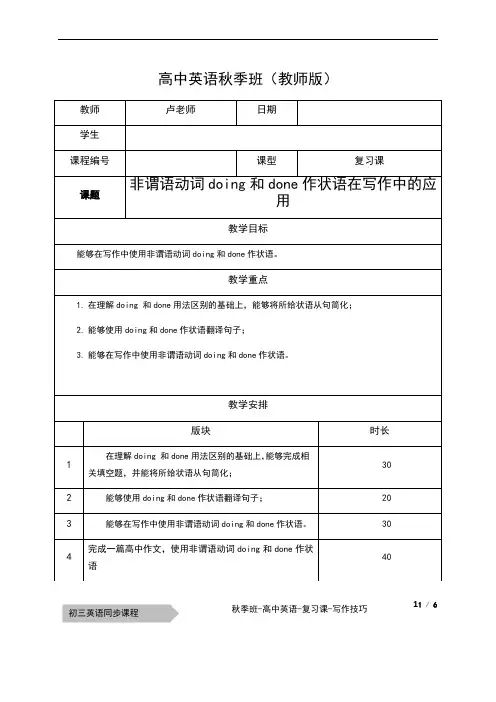
高中英语秋季班(教师版)11 / 6初三英语同步课程秋季班-高中英语-复习课-写作技巧22 / 6初三英语同步课程秋季班-高中英语-复习课-写作技巧v1.0 可编辑可修改33 / 6初三英语同步课程 秋季班-高中英语-复习课-写作技巧一、用动词的适当形式填空:非谓语动词作状语大多相当于一个状语从句A.作时间状语:eg.)①_______ (hear) the bad news, they couldn’t help crying.= _______________, they couldn’t help crying.②When/ While( _____ _____ ) ____ (take) around the city, we were deeply impressed by the city’s new look.While/When (I was) _____ (wander) through the square, I caught sight of a snake-charmer. ③_______ (finish) his work, he went home.=_____________, he went home.B.作原因状语:Eg.) ①_____ (be poor), he could not afford to travel abroad.=____________, he could not afford to travel abroad.________ (encourage) by his heroic deeds, they worked harder._______ (lose) in thought, he almost ran into a post.________ (frighten) by the big forest fire, the animals all ran away._____ (not know) her address, we couldn't get in touch with her.②______ (never be) to the city, he soon got lost._________ (not receive) his letter, I decided to call him up.知识点讲解=_____________.C.方式/伴随状语;Eg.)①She watched the film, _____ (weep ) and ___ (sigh).②The teacher stood there, ______ (surround) by a lot of students.D.作条件状语:Eg.)①______ (give) another chance, I would have done the job far better.=______________ , I would have done the job far better.②(If) _____ (play) all day, you will waste your valuable time.E.作结果状语:(意料中的结果)Eg.)① The hunters fired, _____(shoot) one of the wolves.②The bus was held up by the snowstorm, thus _____ (cause) the delay.区别: 不定式表示意外的结果eg.) He hurried to the station, only ____ (find) the train had left.F.作让步状语:Eg.)①Though ____ (rain) heavily, it cleared up very soon.= _____________, it cleared up very soon.②Though _____ (tell) of the danger, he still risked his life to save the boy.分词作状语时, 需注意事项:A.分词短语作状语时,它的逻辑主语通常应是________ :____ (see) from the hill, the city is beautiful.___ (see) from the hill, you can see the whole city二、使用doing和done简化以下状语从句:44 / 6初三英语同步课程秋季班-高中英语-复习课-写作技巧1.When arriving, send me a telegram. (When you arrive, send me a telegram.) 到达之后,来个电报。

(高考非谓语动词用法总结)非谓语动词用法总结非谓语动词是历年高考英语的重要考点之一,也是较难掌握的难点之一。
它贯穿于英语学习和考试过程的始终。
但是,只要认真分析、透彻理解、看透本质、准确把握,就一定能在高考中运筹帷幄,游刃有余。
不定式不可作谓语,但它可以有自己的宾语、状语,构成不定式短语,在句中可以作主语、宾语、表语、定语(表用途)、状语或补足语。
高考对不定式的考查主要有不定式的时态、语态、作用、否定、省略、连词+不定式等。
1.作主语不定式作主语表示具体的动作,通常指一件已知的事或目的。
不定式作主语时,谓语动词用单数。
eg:To say is a thing,to do is another.(说是一回事,做是另外一回事。
) (2)不定式短语较长时,通常放在谓语之后,用it作形式主语。
eg:①It is important to learn English well.(学好英语是重要的。
)②It is necessary for us to do the job well.(我们做好这项工作是必要的。
)③It is a great honor to be invited to give a speech here.(被邀请在这儿发表演讲是一个极大的荣幸。
)2.作宾语(1)常只用不定式作宾语的动词有:want,wish,hope,long,expect,desire,intend,decide,ask,promise,aim,offer,ag ree,plan,learn,choose,refuse,fail,manage,pretend等。
eg:①He refused to help me.(他拒绝帮助我.)②She has agreed to come tomorrow.(他已同意明天来.)(2) 不定式较长时,作宾语,也可用it代替,放在后面。
eg;I find it difficult to do the job well.(3) “特殊疑问词﹢不定式to do结构”具有名词特征,可作宾语。
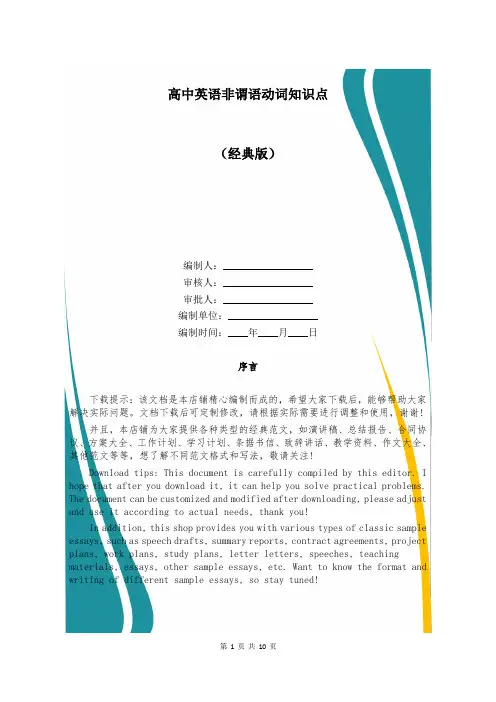
高中英语非谓语动词知识点(经典版)编制人:__________________审核人:__________________审批人:__________________编制单位:__________________编制时间:____年____月____日序言下载提示:该文档是本店铺精心编制而成的,希望大家下载后,能够帮助大家解决实际问题。
文档下载后可定制修改,请根据实际需要进行调整和使用,谢谢!并且,本店铺为大家提供各种类型的经典范文,如演讲稿、总结报告、合同协议、方案大全、工作计划、学习计划、条据书信、致辞讲话、教学资料、作文大全、其他范文等等,想了解不同范文格式和写法,敬请关注!Download tips: This document is carefully compiled by this editor. I hope that after you download it, it can help you solve practical problems. The document can be customized and modified after downloading, please adjust and use it according to actual needs, thank you!In addition, this shop provides you with various types of classic sample essays, such as speech drafts, summary reports, contract agreements, project plans, work plans, study plans, letter letters, speeches, teaching materials, essays, other sample essays, etc. Want to know the format and writing of different sample essays, so stay tuned!高中英语非谓语动词知识点有知识者与无知识者的区别,是前者受了苦会抱怨,会诉苦,后者却讷讷不能言。
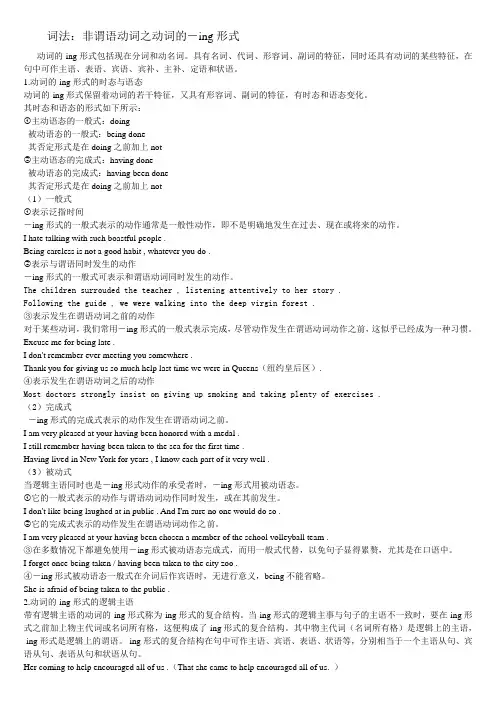
词法:非谓语动词之动词的-ing形式动词的-ing形式包括现在分词和动名词。
具有名词、代词、形容词、副词的特征,同时还具有动词的某些特征,在句中可作主语、表语、宾语、宾补、主补、定语和状语。
1.动词的-ing形式的时态与语态动词的-ing形式保留着动词的若干特征,又具有形容词、副词的特征,有时态和语态变化。
其时态和语态的形式如下所示:①主动语态的一般式:doing被动语态的一般式:being done其否定形式是在doing之前加上not②主动语态的完成式:having done被动语态的完成式:having been done其否定形式是在doing之前加上not(1)一般式①表示泛指时间-ing形式的一般式表示的动作通常是一般性动作,即不是明确地发生在过去、现在或将来的动作。
I hate talking with such boastful people .Being careless is not a good habit , whatever you do .②表示与谓语同时发生的动作-ing形式的一般式可表示和谓语动词同时发生的动作。
The children surrouded the teacher , listening attentively to her story .Following the guide , we were walking into the deep virgin forest .③表示发生在谓语动词之前的动作对于某些动词,我们常用-ing形式的一般式表示完成,尽管动作发生在谓语动词动作之前,这似乎已经成为一种习惯。
Excuse me for being late .I don't remember ever meeting you somewhere .Thank you for giving us so much help last time we were in Queens(纽约皇后区).④表示发生在谓语动词之后的动作Most doctors strongly insist on giving up smoking and taking plenty of exercises .(2)完成式-ing形式的完成式表示的动作发生在谓语动词之前。
do homework1. Chen asked me 1. Chen asked me that I needed to do my work.2 The homework that Chen asked us to do is difficult.3. That I need to do my work everyday is boring.4.1. doingI am doing my homework now.Doing my homework cost me a lot of time. Doing my homework, I received your call.=When I was doing my work, I ….Doing homework is very time consuming.The man (who is) doing homework is Chen.I enjoy doing my homework.The falling leaves are interesting.This is a walking stick.This is a walking cat.2. being doneMy homework being done, I answered your call.The homework being done by Chen is difficult.I am appreciated being given an opportunity to study abroad.3. having doneHaving done his homework, Chen watched TV. =After he had done his homework, Chenwatched TV.I enjoy having given an opportunity to you to study abroad two years ago.4. having been doneHaving been done, my homework was checked by by Chen.I am appreciated having been given an opportunity to study abroad two years ago.5. to doI want to do my homework.To do my homework will cost me a lot of time. Chen is said to do the homework.6. to be doneThe homework to be done is difficult.The homework that will be done is difficult.The homework being done is difficult.done last week is difficult.China is reported to have won the competition last year.China was reported the competition last year.The home work to do is difficult.The building to be built at the end of this year is a gymnasium.The work is said to be done by Chen.7. to have doneChen is said to do the homework next week. Chen is said to have done the homework last week.8. to have been doneThe work is said to have been done by Chen last week. .9. doneThe Chen last week is/was important.The work done by Chen last week is/was important.= The Chen last week is/was important.Seen from the moon, the earth looks like a blue ball.Being seen from the moon, the earth looks like a blue ball.The fallen leaves are interesting.The falling leaves are interesting.I want to drink boiled/boiling water.。
探究非谓语动词 having done 和 having been done 的应用在英语语法中,非谓语动词做伴随状语的情况比较常见,其中 having done 和 having been done 是两个常用的形式。
本文将介绍它们的含义、用法和区别。
下面是本店铺为大家精心编写的5篇《探究非谓语动词 having done 和 having been done 的应用》,供大家借鉴与参考,希望对大家有所帮助。
《探究非谓语动词 having done 和 having been done 的应用》篇1一、having done 的用法having done 是现在分词的完成式,表示动作在谓语动词之前发生,并且对谓语动词有伴随作用。
having done 通常用于以下几种情况:1. 完成式的伴随状语having done 可以用于完成式的伴随状语,表示在谓语动词之前完成的动作。
例如:- Having finished my homework, I went to bed.(完成作业后,我去睡觉了。
)2. 结果状的伴随状语having done 还可以用于结果状的伴随状语,表示动作完成的结果。
例如:- Having broken his arm, he had to go to the hospital.(摔断手臂后,他不得不去医院。
)二、having been done 的用法having been done 是现在分词的完成被动式,表示被动动作在谓语动词之前发生,并且对谓语动词有伴随作用。
having been done 通常用于以下几种情况:1. 被动式的伴随状语having been done 可以用于被动式的伴随状语,表示在谓语动词之前发生的被动动作。
例如:- Having been invited to the party, she was excited to attend.(被邀请参加聚会后,她很兴奋地去了。
非谓语having done的用法
非谓语中的having done是现在分词的完成式,它表示主动的动作,并且动作发生在谓语动词之前,常常作状语来修饰动词。
done过去分词无论作状语或作定语,都表示被动的动作,也可以表示已经完成的动作。
having done例句
Having done these things, he went on again.
做完这些事,他又继续往前走。
Having done quite well in the important exam, he came back home, relaxed and smiling.
他在这场重要的考试中做得很好,他放松地回到家,面带微笑。
It would be rash to try an exam like BEC Higher without having done any preparation at all, even if your English is very good.
即使你的英语很好,如果你没有做任何准备就参加 BEC 高级考试,那也太草率了。
You can congratulate yourself on having done an excellent job.
你应该为你出色的工作感到自豪。
Having done that,she now could rest.
做完了这些事,现在她可以安息了。
He felt ashamed of having done so little.
他为自己干得太少而感到羞愧。
非谓语having done什么是非谓语having done?这是一个术语,指的是完成时态,也就是一个动词的完成式形式。
它在英文中表示一种动作已经完成,而不是正在发生或尚未发生。
例如,“I have done my homework.” 就是一句典型的非谓语having done句子,这句话表明说话者已经完成了家庭作业。
完成时态通常用于主动句式,但也可以用于被动句式。
例如,“My homework has been done.” 就是一句典型的被动句式的非谓语having done句子,表明家庭作业已经完成。
在英语中,非谓语having done也可以表示一种趋势,即一件事将发生,但尚未发生,或可能发生。
例如,“The sun is having the clouds move away.” 表明太阳的能量正在将云朵向远处推移。
总之,非谓语having done是一种语法术语,它指的是一种完成时态,表明一件事情已经完成,或一件事即将发生或可能发生。
非谓语having done也可以用来表示一种能力或技能,即具有某种技能的能力。
例如,“I am having a great knowledge of computer programming languages.” 表明说话者具有很强的计算机编程语言知识。
此外,非谓语having done还可以用于表示一种情感,即对某种情况或做法的满意度或不满意度。
例如,“I'm having trouble understanding the instructions.” 表明说话者对指令的理解有一定困难。
总之,非谓语having done是一种语法术语,它指代一种完成时态,表达一种动作已经完成、将要发生或可能发生的意思,也可以用来表示一种能力或技能,或一种情感。
非谓语having done也可以用作一种假设,即对某种情况的猜测或揣测。
例如,“I am having the feeling that she will come.” 表明说话者猜测她将会来。
非谓语havingdone的用法非谓语动词是指在句中作状语、定语或补足语时不带有时态和人称的动词形式,常用的非谓语动词有不定式、动名词和分词。
其中,非谓语动词“having done”是一个现在分词的完成式,表示动作在谓语动词所表示的动作之前发生或完成。
以下是“having done”用法的详细解释。
一、作状语“having done”作为状语时,常表示时间顺序、原因、条件、目的、结果等,用来修饰整个句子或主句的内容,充当原因、时间等状语。
常见的句式有:1.时间状语从句Having done his homework, Tom went to bed.(做完作业后,汤姆去睡觉了。
)2.假设状语从句(受伤后,约翰无法参加比赛。
)3.结果状语从句Having failed the exam, he felt very disappointed.(考试不及格,他感到非常失望。
)4.目的状语从句Having finished his work, he left the office.(完成工作后,他离开了办公室。
)二、作定语“having done”作为定语时,常用于名词或代词之后,修饰主语,表示主语在句意中的其中一动作已经完成。
1.名词的定语The boy, having finished his homework, went out to play.(那个男孩完成了作业后,出去玩了。
)2.代词的定语She went upstairs, having found the keys.(她找到钥匙后去楼上了。
)三、作补足语“having done”作为补足语时,常跟在宾语之后,用来修饰或补充说明宾语的内容,意义上相当于一个定语从句或独立副词。
1.补充宾语内容I'm happy with my life, having achieved my goals.(实现了我的目标,我对我的生活感到满足。
)2.与宾语同时发生的动作She sat down, having put the heavy bag on the floor.(她放下沉重的包后坐下来。
非谓语having done的用法
非谓语中的having done是现在分词的完成式,它表示主动的动作,并且动作发生在谓语动词之前,常常作状语来修饰动词。
done过去分词无论作状语或作定语,都表示被动的动作,也可以表示已经完成的动作。
having done例句
Having done these things, he went on again.
做完这些事,他又继续往前走。
Having done quite well in the important exam, he came back home, relaxed and smiling.
他在这场重要的考试中做得很好,他放松地回到家,面带微笑。
It would be rash to try an exam like BEC Higher without having done any preparation at all, even if your English is very good.
即使你的英语很好,如果你没有做任何准备就参加 BEC 高级考试,那也太草率了。
You can congratulate yourself on having done an excellent job.
你应该为你出色的工作感到自豪。
Having done that,she now could rest.
做完了这些事,现在她可以安息了。
He felt ashamed of having done so little.
他为自己干得太少而感到羞愧。